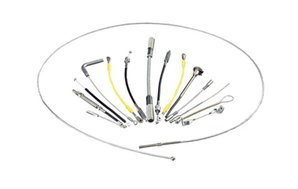 How to avoid fatigue and loss of strength from wire rope bending
How to avoid fatigue and loss of strength from wire rope bending
October 27, 2016 REDWIRE is news you can use from leading suppliers. Powered by FRASERS.
Posted by Bergen Cable Technology, Inc
Mfr Mechanical Cable, Cable Assemblies & Push-Pull Controls. Original Mfr Of Safety Cable, A Patented Fastener Reten... Read more
Subscribe
Free REDWIRE e-newsletter

When wire rope is subjected to bending around sheaves or drums, it often results in loss of strength or increased fatigue, which shortens the life of the rope. However, this can be avoided. As a leading manufacturer of cable assemblies, Bergen Cable Technology has this advice:
Keep the strength
A rope loses strength when its individual strands and wires are unable to adjust to their changed position when the rope is bent. And repetitive flexing of the wires only intensifies this, resulting in points of stress concentration.
To avoid this, individual wires and strands must be able to slide upon one another when the rope is bent. Therefore, it’s essential that wire rope is properly lubricated and that drums and sheaves are properly sized. Keep in mind that the loss of strength due to bending wire ropes over the sheaves found in common use will usually be about four per cent, and should not exceed six per cent.
Avoid the fatigue effect
The fatigue effect of bending appears in the form of small cracks in the wires at over-stressed points. These cracks grow under repeated stress cycles, until the remaining sound metal can no longer withstand the bending load, resulting in broken wires.
To prevent this from happening, it’s important to understand the relationship between the size of the individual outer wires of a wire rope and the size of the sheave or drum about which it operates. Sheaves and drums smaller than 200 times the diameter of the outer wires will cause permanent set in a heavily loaded rope. It is good practice to use sheaves and drums with diameters 800 times the diameter of the outer wires in the rope for heavily loaded fast-moving ropes.
Additional tips
Reverse bends should be avoided if possible. This is because when a rope is bent in one direction and then in the opposite direction, it causes excessive fatigue. But if a reverse bend is necessary, larger sheaves are required.
There are multiple factors that affect the performance and lifespan of the rope. It’s important to work with a manufacturer that understands how to get the best performance out of a wire rope.
Contact Bergen Cable Technology to learn more.
Share
Posted by Bergen Cable Technology, Inc
Mfr Mechanical Cable, Cable Assemblies & Push-Pull Controls. Original Mfr Of Safety Cable, A Patented Fastener Reten... Read more
